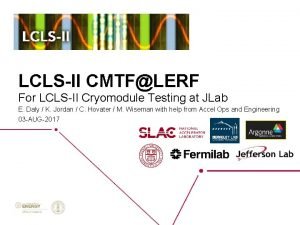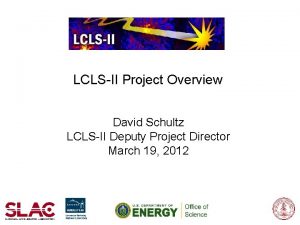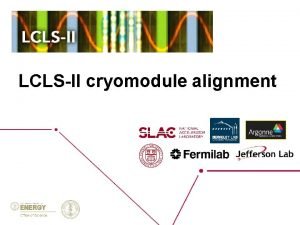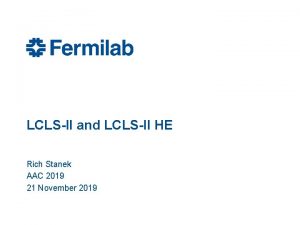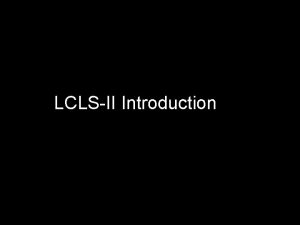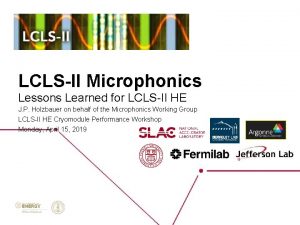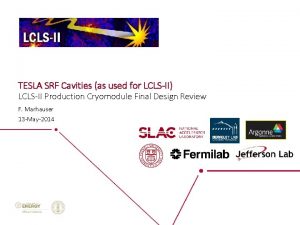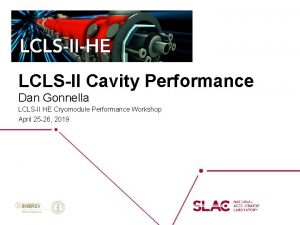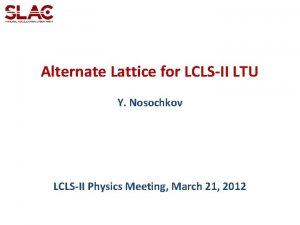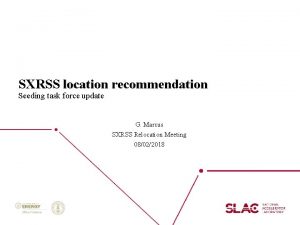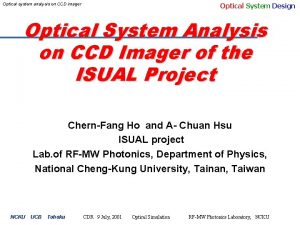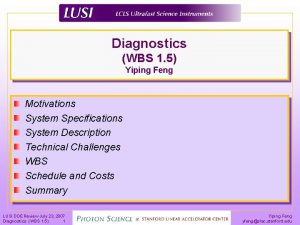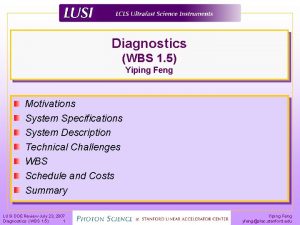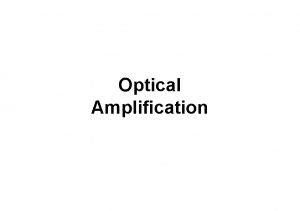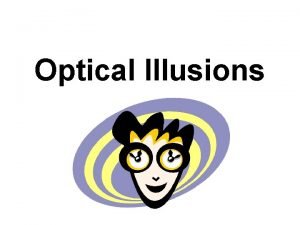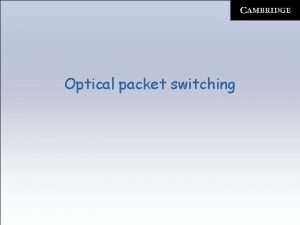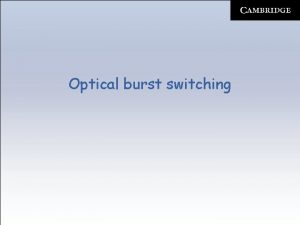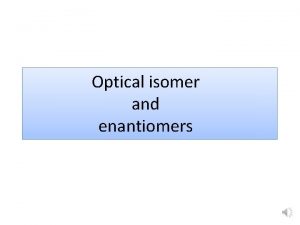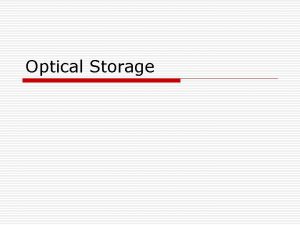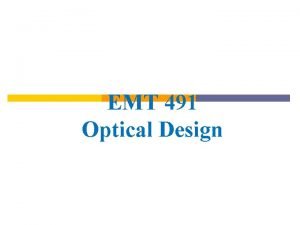Optical Design Concept for LCLSII SXRSS System Yiping

































































- Slides: 65

Optical Design Concept for LCLS-II SXRSS System Yiping Feng March 09, 2016

Soft X-ray Self-Seeding (SXRSS) • LCLS-II project seeding deliverables • LCLS-I system & physics requirements • LCLS-II baseline/refined system & physics requirements • LCLS-II high-resolution design concept • • Grating and optics Mode of operation (tuning) Resolution Imaging of source onto re-entrant point Coupling of X-ray and e- beams Efficiency and throughput Tolerances LCLS-II SXRSS Optical Design *LCLS-II SXRSS CDR Scheduled in Sept. 2015 2

Current LCLS-II Efforts in Relation to SXRSS • Tor Raubenheimer, LCLS-II physics • Gabriel Marcus, FEL physics • Yiping Feng, XTES X-ray physics • Michael Rowen, photon system • Dennis Martinez-Galarce, undulator systems CAM including SXRSS system • In consultation with: • Bob Schoenlein, Daniele Cocco, Phil Heimann, Lin Zhang, Zhirong Huang, Daniel Ratner LCLS-II SXRSS Optical Design 3

LCLS-II Baseline Deliverables Cu Linac 4. 0 Ge. V SC Linac High Rep Rate 0 5 10 15 20 25 Photon Energy (ke. V) Legend Cu SASE Self Seeded (Diamond) High Rep Rate SASE Self Seeded (Grating) LCLS-II SXRSS Optical Design Ø Self seeding between 1. 2 - 4 ke. V requires X-ray optics development Ø Self seeding at high rep rate above 4 ke. V will require ~ 4. 5 Ge. V electron beam, not a baseline deliverable today 4

LCLS-II Project Baseline Physics Requirements* LCLS-II SXRSS Optical Design *Marcus et al, LCLS-II SXRSS PRD *Optics expected to be cooled due to high rep rate operation 5

Modify/Upgrade Existing LCLS-I System (w/ cooling modifications for High Rep-Rate as an option) Length of Undulator Segment 3. 870 m 1. 453 m 0. 26 m B 2 18 mm B 1 B 3 E = 1000 e. V Grating (toroidal VLS) (End of Girder) 0. 26 m M 1 (rotating planar mirror) B 4 Dt = 663 fs Slit (fixed) 3. 85 mm M 3 ( plane mirror) FEL M 2 (tangential cylindrical mirror) 0. 0 xx m 1. 347 m 0. 18 m 0. 128 m 1. 190 m 1. 346 m e- beam 0. 8315 m 0. 8243 m 0. 235 m 3. 400 m LCLS-II SXRSS Optical Design Magnetic Length of Undulator 0. 235 m 0. 665 m (End of U 9) (Begin of U 9) (End of U 8) 0. 470 m 6

Optics/Grating Design for LCLS-I Nearly Constant Resolving Power @ 5, 000 • Toroidal VLS grating • Variable-line spacing providing main focusing in dispersion plane • In “fixed incidence angle” mode, focus not fixed • due to variable source location • chromatic aberrations from grating both in VLS and spherical focusing in dispersive conf. • chromatic aberrations from Gaussian beam optics due to Rayleigh range dependences on l and w 0 • Providing additional focusing in dispersion plane • Providing main focusing in sagittal plane LCLS-II SXRSS Optical Design 7

Optics/Grating Design for LCLS-I • Mirrors • Rotating planar M 1, providing energy tuning • Tangential cylindrical M 2 at fixed incidence angle, providing re-focusing in dispersion plane • Planar M 3 at fixed incidence angle, completing optical chicane and providing certain alignment capabilities • Exit slit • Variable size, providing resolution tuning* • In practice, running slit-less and relying on e- beam being the effective slit (more discussion later) LCLS-II SXRSS Optical Design *although effect is different from conventional mono system 8

Refined Physics Requirements under C for Higher Resolving Power* > 30000 LCLS-II SXRSS Optical Design *guidance from LCLS scientific staff based on workshop and SAC recommendations and CD 2/3 review, etc. 9

Optical Concept for LCLS-II SXRSS Schematic Layout (U 9) Length of Undulator Segment 4. 400 m 1. 453 m 0. 26 m B 2 18 mm B 1 Grating (rotating plane VLS) M 1 (rotating plane mirror) 0. 26 m B 3 @ E = 1000 e. V B 4 Dt ~ 700 fs Slit (movable) 3. 85 mm e- beam M 3 FEL (rotating & movable plane mirror) M 2 (rotating & movable toroidal mirror) 0. 052 m 1343. 736 -1350. 200 m 0. 1346 - 0. 0645 m 0. 0805 - 0. 1631 m 1. 8757 m 0. 5194 - 0. 5259 m 0. 8243 m 0. 500 m 3. 400 m LCLS-II SXRSS Optical Design Magnetic Length of Undulator 0. 500 m 0. 500 (End of U 9) (Begin of U 9) 1. 000 m 10

Optics/Grating Design for LCLS-II (w/ flexibilities) Nearly Constant Resolving Power @ 30, 000 • Rotating plane VLS grating • Variable-line spacing providing main focusing in dispersion plane • In “fixed-focus” mode* by rotating grating and M 1 for energy tuning, but focus still not fixed due to • Variable source location • Chromatic aberrations from grating in VLS • Chromatic aberrations from Gaussian beam optics due to Rayleigh range dependences on l and w 0, degree of transverse coherence b LCLS-II SXRSS Optical Design *fixed incidence produced large aberrations, was not chosen, and for the more exotic design of variable RP, would not work either 11

Optics/Grating Design for LCLS-II (w/ flexibilities) • Mirrors • Rotating planar M 1, providing tuning in conjunction w/ grating • Rotating and movable toroidal M 2, providing optimal refocusing in both dispersion and sagittal plane • Rotating planar and movable M 3, completing optical chicane and certain alignment capabilities • Exit slit • Variable size and movable, providing resolution tuning* LCLS-II SXRSS Optical Design *cannot run slit-less if high resolving power is required 12

Enhanced Capabilities and Increased Complexities • Higher resolving power • ~ 30, 000, matching state-of-the-art system at synchrotrons • Slit must be used at high RP • Tunability w/ high RP at the expense of increased mechanical complexity • Coarse energy tuning using G, M 1, M 2, M 3, and slit • Fine energy tuning using G and M 1 only • Necessitated by the higher RP, and thus higher demagnification at slit, a short focal length of M 2 for refocusing; aberration must be compensated to achieving better beam size match at reentrant point, and thus higher coupling efficiency LCLS-II SXRSS Optical Design 13

Resolving Power Achieved only w/ Slit • Based on: angular dispersion > beam angular size • Dispersion must overcome diffraction Re-focused beam size at reentrant point Angular dispersion at 5000 resolving power Angular dispersion at 30000 resolving power LCLS-II SXRSS Optical Design 14

Why LCLS-I system can work w/o slit? • Based on: angular dispersion ~ beam angular size LCLS-II SXRSS Optical Design 15

Why Focusing is Required for Resolution? Focusing requirements • Imaging angular size < grating angular dispersion • r ’ ~ 1. 35 m • Image angular size < 1. 05 mrad @ 1. 3 ke. V - w 0’ < 1. 35 mm (to be focused from ~ 50 mm at src. + propagation) l+Dl w 0’ w 0 l r • Possible solutions - r’ Focusing element (VLS) exit slit Focusing pre-mirror Spherical grating (fixed line spacing) Plane variable line spacing (VLS) grating Spherical +VLS grating LCLS-II SXRSS Optical Design 16

High Demagnification at Slit • Based on required resolving power and beam angular size at slit location* • Must be provided by 1 st stage focusing (VLS, or else) Achieved by optics design Required based on resolving power LCLS-II SXRSS Optical Design *1350 mm from grating 17

Source Properties (Based Gabe Marcus’ S 2 E Simulations) • Source location, waist size and 1 D degree of transverse coherence (complete description of photon beam) • Coherent treatment is necessary because of near-field condition upstream end of undulator 8 downstream end of undulator 8 LCLS-II SXRSS Optical Design 18

Gaussian-Schell Model Propagation (Based Gabe Marcus’ S 2 E Simulations) • Source location, waist size and 1 D degree of transverse coherence (complete description of photon beam) Gaussian-Schell Model Fully Coherent LCLS-II SXRSS Optical Design 19

Maximum Resolving Power (limited by illuminated # of grooves) • Maximum RP > 30, 000 @ 1. 3 ke. V • Ideally, resolving should go lower as X-ray energy decreases Current design m al e Id LCLS-II SXRSS Optical Design te ys s 20

Design RP vs. Transform-limited Pulses (Not ideal!) • Partial coverage of phase space • Stretching pulse, especially for shorter pulse at lower energies, thus reducing coupling efficiency LCLS-II SXRSS Optical Design 21

Image (Waist) Location near Slit • Image location not “fixed” completely moveable slit • Aberrations from VLS, variable src. location, etc. Gaussian. Schell optics, some of them not known a priori Coherent-optics Ray-optics slit LCLS-II SXRSS Optical Design 22

Tuning of energy (Incident & Exit Angles vs. Energy) • In “fixed-focus” mode defined for incoherent optics in the small angle limit, incidence, exit, and included angle all variable • It is possible to vary incidence angle to completely fix focus exit on grating incidence on M 1 incidence on grating LCLS-II SXRSS Optical Design 23

Focusing in Dispersion/Sagittal Planes • Tangential/dispersion plane Focusing (VLS) src. point Exit slit M 2 tangential focusing re-ent. point w 0’ l+Dl w 0 l • Sagittal/non-dispersive plane Exit slit src. point l+Dl w 0 M 2 sagittal focusing re-ent. point w 0’ l LCLS-II SXRSS Optical Design 24

Re-focusing in Dispersion Plane (optimized to couple w/ e- beam) • Achieved by optimizing M 2 location, incidence angle, and slit translation/size for required RP Source waist size Waist size in reentrant undulator LCLS-II SXRSS Optical Design 25

Re-focusing in Dispersion Plane (optimized to couple w/ e- beam) • Location of waist not fixed, but moves within undulator • Rayleigh range ~ 1. 1 to 3. 8 m so it helps somewhat ator th Leng dul of un Beam size LCLS-II SXRSS Optical Design 26

Re-focusing in Sagittal Plane (optimized to couple w/ e- beam) • Achieved by concurrently optimizing M 2 location, incidence angle, and slit translation/size for required RP Source waist size Waist size in reentrant undulator LCLS-II SXRSS Optical Design 27

Re-focusing in Sagittal Plane (optimized to couple w/ e- beam) • Location of waist not fixed, but moves within undulator • Rayleigh range ~ 1. 0 to 4. 8 m so it helps somewhat 200 e. V 1. 3 ke. V Location in undulator after chicane (mm) LCLS-II SXRSS Optical Design 28

Quality Factor of Overlapping (optimized to couple w/ e- beam) • Complex optimization process, involving slit-M 2 distance, M 2 incidence angle, M 2 radii of curvature in tangential/sagittal directions LCLS-II SXRSS Optical Design 29

Grating/Optics Efficiency (not including bandwidth reduction factor) • For lamella grating w/o shadowing, but blazed design can help compensate, especially at higher energies • Whether or not sufficient? S 2 E simulation Max. grating efficiency Est. reflectivity Overall grating efficiency LCLS-II SXRSS Optical Design 30

Optical Time Delay (not constant due to varying included angle) • Not constant due to included angle changing, especially at low energies, but the Dt/ev is very small, and can be reduced by limiting number of motions Max. grating efficiency Est. reflectivity Overall grating efficiency LCLS-II SXRSS Optical Design 31

How Would Slit Work? (required for achieving high resolving power) • Translation of slit to “track” waist of focused beam necessary • Very small Rayleigh range of the focused beam near slit Beam size at slit if not moved Rayleigh range Waist size near slit LCLS-II SXRSS Optical Design 32

How Would Slit Work? (required for achieving high resolving power) • To optimize beam size matching, tangential and sagittal focal length were made variable • M 2 motion must be follow prescribed trajectory Prescribed M 2 to Image(slit if movable) distance Focal length LCLS-II SXRSS Optical Design 33

How Would Slit Work? (required for achieving high resolving power) • To optimize beam size matching, tangential and sagittal focal length were made variable • M 2 Incidence angle must follow prescribed trajectory LCLS-II SXRSS Optical Design 34

Ideal System Concept (Resolving power on demand) • Full coverage of phase space • Variable resolving power vs. energy at constant pulse length • Multiple configurations cover different pulse length conf. I How to adjust RP for constant bunch length? conf. III I. Vary incidence angle II. Adjust slit opening LCLS-II SXRSS Optical Design 35

Re-mixing of Separated Colors (Transform-limited resolving power for a given pulse length ) • Varying exit slit opening • By opening up exit slit, allowing more colors to go thru. , of each color pulse length stretched to many times of transform-limited due to narrower than necessary bandwidth • Phases of colors remain locked at slit location, will remain locked at re-entrant point after collimation • Many colors of longer pulses re-combine to form shorter pulse with greater bandwidth (requires verification) Focusing (VLS) src. point Exit slit l+Dl w 0 M 2 tangential focusing re-ent. point w 0’ l LCLS-II SXRSS Optical Design 36

Variable Resolving Power Design (Transform-limited resolving power for a given pulse length ) • Varying incidence angle on grating to match transform-limited resolving power requirement const. RP design variable RP design LCLS-II SXRSS Optical Design 37

Variable Resolving Power Design (Transform-limited resolving power for a given pulse length ) • Coupling of variable RP design suffers a bit at lower energies due to large aberration, but reasonable, range of motion adjustments are similar const. RP design variable RP design LCLS-II SXRSS Optical Design 38

Optics Specs for Const. RP Design 39 Grating specifications Parameter symbol value unit Line spacing s 0. 4452 mm Linear coeff Ds/Dx -6. 621 x 10 -7 Groove height h 15. 6 Grating profile nm Blazed @ 2. 0° Incident angle q 11. 11 - 4. 37 mrad Exit angle q’ 167. 45 - 65. 61 mrad Included angle 2 q 169. 77 - 175. 99 degree Object distance Lobj 2. 648 - 4. 277 m Image distance Limg 1. 344 -1. 350 m Exit slit opening s 1. 47 - 0. 56 mm

Optics Specs for Const. RP Design 40 Mirror specifications Parameter symbol value unit M 2 Sagittal Radius Rs 0. 10452 m focal length f 1 2. 1868 - 4. 4289 m Incident angle qi 23. 9 - 11. 8 mrad M 2 Tangential Radius Rd 11. 00845 m focal length f 3 0. 1315 - 0. 0650 m Incident angle qi 23. 9 - 11. 8 mrad

Optics Specs for Const. RP Design 41 Performance Parameter symbol value unit Energy range E 0. 200 – 1. 300 ke. V Bunch charge Q 100 p. C Pulse length (FWHM) t 100 fs Pulse energy e 6 - 1. 4 m. J Peak Power Pinput 60 - 14 MW g-beam size (2 s) w. G 46. 78 - 40. 00 mm g-beam DTC-1 D b 94. 3 - 90. 6 % Resolving power R ~ 30000 - Grating efficiency h. Grating 3. 77 - 0. 58 % Coupling efficiency hg-e- 59. 7 - 84. 5 % Bandwidth ratio Dwo/Dwi - Output peak Power Poutput k. W Time delay (variable) DT 1457 - 601 fs

Quality Factor of Overlapping (tolerance studies) • Varying DTC-1 D • From highly coherent to 0. 9, 0. 8, . . . , 0. 1 1. 0 0. 5 0. 1 LCLS-II SXRSS Optical Design 42

M 2 Parameters (Incidence Angle, location) (tolerance studies) • Varying M 2 parameters • Incidence angle, location, aberration, and all of the three effects Including all three effects not including aberration const. offset const. incidence angle LCLS-II SXRSS Optical Design 43

Source Parameters (Source location) (tolerance studies) • Varying source parameters • Constant source location, varying source location +/- 0. 5 m variable source location + 0. 5 m variable source location - 0. 5 m const. source location LCLS-II SXRSS Optical Design 44

Grating Parameters (Incidence Angle) (tolerance studies) • Varying grating parameters • Constant incidence angle won’t work well const. incidence angle on grating LCLS-II SXRSS Optical Design 45

M 2 Radius of Curvature (Tangential) (tolerance studies) • Varying M 2 radius of curvature • Optimal, +/- 10% 0% -10% +10% LCLS-II SXRSS Optical Design 46

M 2 Radius of Curvature (Sagittal) (tolerance studies) • Varying M 2 radius of curvature • Optimal, +/- 10% 0% -10% +10% LCLS-II SXRSS Optical Design 47

VLS 1 st Order Coeff. (tolerance studies) • Varying VLS 1 st order coefficient • Optimal, +/- 0. 1% 0% -0. 1% +0. 1% LCLS-II SXRSS Optical Design 48

VLS Grating Period (tolerance studies) • Varying VLS grating period, similar to 1 st order coeff. • Optimal, +/- 0. 1% 0% +0. 1% -0. 1% LCLS-II SXRSS Optical Design 49

Higher Order Effects (due to large incidence angle on M 1) • Large incidence angle on M 1 will lead to • Under-rotation of M 1, Shift in slit location (up in y), landing point on M 1 close to grating h/2 qi+q 0 pivot h/2 c c exit slit M 1 S S Dy • z. M 1 z. S Exit ray not parallel to S-S line, shift at slit location (down in y), landing point on M 1 away from grating h/2 pivot h/2 S qi+q 0 z z>x z’M 1 LCLS-II SXRSS Optical Design Dy’ M 1 exit slit S z. S 50

Higher Order Effects (due to large incidence angle on M 1) • Varying slit location in y • Much larger than waist size at slit, so it is important LCLS-II SXRSS Optical Design 51

LCLS-I System (comparison of coupling efficiency) • LCLS-I system design very rigid for stability, no adjustments • Source parameters require verification/testing LCLS-II system LCLS-I system as specified LCLS-II SXRSS Optical Design 52

Summary • High resolution system feasible • Resolving power ~ 30, 000 over entire energy range • Use of slit necessary for high resolving power • Efficiency reasonable ~ 1% • Imaging properties in both transverse directions can be optimized, but requires many degrees of freedom • Incidence angle, location of re-focusing optics • Tuning can be achieved w/ certain mechanical complexities • However tuning over small energy range can work w/ motion of one mirror only LCLS-II SXRSS Optical Design 53

Additional Information

Current LCLS-I Soft X-ray Self Seeding System Installed in place of U 9 LCLS-II SXRSS Optical Design 55

Current LCLS-I System Physics Specifications* resolving power LCLS-II SXRSS Optical Design 5000 *D. Ratner, et al, PDR for SXRSS 56

Current Performance of LCLS-I System at 930 e. V, 50 fs, ~ x 3 transform-limited LCLS-II SXRSS Optical Design *D. Ratner, et al, Phys. Rev. Lett. 114, 054801 (2015) 57

BESAC Recommendations for Future Light Sources* Transform-limited pulses • For a (temporal) Gaussian beam *Approved by BESAC, July 25, 2013 LCLS-II SXRSS Optical Design 58

Comments from LCLS-II CD 3 B Review The project should solicit broad input from LCLS/LCLS-II user community concerning target energy resolution in SXR seeding. Achieving very high resolving power (e. g. , > 105) on an FEL will be very challenging and is probably not wellsuited to LCLS-II science. LCLS-II SXRSS Optical Design 59

LCLS-II Scientific Opportunities Workshop Will help refine science case and will provide guidance on operating modes Close coordination with LCLS and Photon Science Directorates LCLS-II SXRSS Optical Design 60

Requirements Performance requirements • Resolving power to make pulse fully transform-limited, assuming Gaussian profile - 200 e. V - 1300 e. V • R ~ 20000 - 30000 • Seeding power after all optics - 200 e. V: > 10 k. W - 1300 e. V: > 20 k. W • Seeding beam collinear w/ original beam - Transverse profile maintained if possible • Time delay - < 1 ps - Variable delay in tuning range is acceptable if within 10% LCLS-II SXRSS Optical Design 61

Things to consider • Tuning capability • High resolving power • Variable resolving power to retain short pulse characteristics • Two-stage implementation • Two-color seeding SS LCLS-II SXRSS Optical Design SS 62

Requirements 63 Transform-limited pulses For a (temporal) Gaussian beam For a (temporal) flat-top beam Photon Division X-ray Science Department

FEL performance requirements • Large tuning range • 0. 20 - 5. 0 ke. V in baseline Parameter Value Unit SXR • Small bandwidth • Self-seeding for both SXR and HXR in baseline • High rep-rate • • 0. 20 – 1. 3 ke. V Self-seeding 0. 20 – 1. 3 ke. V Pulse duration < 100 fs Rep. rate > 100 k. Hz Up to 1 MHz Average x-ray power • • Photon energy 20 W without distortions Up to 200 W hard cap HXR Photon energy 1. 0 – 5. 0 ke. V Self-seeding* 1. 0 – 4. 0 ke. V Pulse duration < 100 fs Rep. rate > 100 k. Hz * Not part of baseline LCLS-II SXRSS Optical Design 64

Nominal e-beam and undulator parameters Symbol Value Unit Parameter Value SXR (HXR) Unit Energy E 4. 0 Ge. V Type Hybrid PM, planar - Charge Q 100 p. C Full gap height Variable - Peak current I 1. 0 k. A Period 39 (26) mm Emittance ϵn 4. 5 x 10 -7 m-rad Segment length 3. 4 m Energy spread σE 500 ke. V Break length 1. 0 m <β> 12 (13) m # segments 21 (32) - Total length 96 (140) m Parameter Beta function • Undulator • • • AL, rectangular pipe 5 mm chamber height Relaxation time, τ = 8 fs LCLS-II SXRSS Optical Design 65
 Kontinuitetshantering i praktiken
Kontinuitetshantering i praktiken Typiska drag för en novell
Typiska drag för en novell Nationell inriktning för artificiell intelligens
Nationell inriktning för artificiell intelligens Returpilarna
Returpilarna Varför kallas perioden 1918-1939 för mellankrigstiden?
Varför kallas perioden 1918-1939 för mellankrigstiden? En lathund för arbete med kontinuitetshantering
En lathund för arbete med kontinuitetshantering Kassaregister ideell förening
Kassaregister ideell förening Personlig tidbok för yrkesförare
Personlig tidbok för yrkesförare Anatomi organ reproduksi
Anatomi organ reproduksi Densitet vatten
Densitet vatten Datorkunskap för nybörjare
Datorkunskap för nybörjare Tack för att ni lyssnade bild
Tack för att ni lyssnade bild Att skriva debattartikel
Att skriva debattartikel Magnetsjukhus
Magnetsjukhus Nyckelkompetenser för livslångt lärande
Nyckelkompetenser för livslångt lärande Påbyggnader för flakfordon
Påbyggnader för flakfordon Lufttryck formel
Lufttryck formel Offentlig förvaltning
Offentlig förvaltning Lyckans minut erik lindorm analys
Lyckans minut erik lindorm analys Presentera för publik crossboss
Presentera för publik crossboss Teckenspråk minoritetsspråk argument
Teckenspråk minoritetsspråk argument Bat mitza
Bat mitza Klassificeringsstruktur för kommunala verksamheter
Klassificeringsstruktur för kommunala verksamheter Epiteltyper
Epiteltyper Bästa kameran för astrofoto
Bästa kameran för astrofoto Centrum för kunskap och säkerhet
Centrum för kunskap och säkerhet Verifikationsplan
Verifikationsplan Mat för idrottare
Mat för idrottare Verktyg för automatisering av utbetalningar
Verktyg för automatisering av utbetalningar Rutin för avvikelsehantering
Rutin för avvikelsehantering Smärtskolan kunskap för livet
Smärtskolan kunskap för livet Ministerstyre för och nackdelar
Ministerstyre för och nackdelar Tack för att ni har lyssnat
Tack för att ni har lyssnat Mall för referat
Mall för referat Redogör för vad psykologi är
Redogör för vad psykologi är Borstål, egenskaper
Borstål, egenskaper Tack för att ni har lyssnat
Tack för att ni har lyssnat Borra hål för knoppar
Borra hål för knoppar Vilken grundregel finns det för tronföljden i sverige?
Vilken grundregel finns det för tronföljden i sverige? Stickprovsvarians
Stickprovsvarians Tack för att ni har lyssnat
Tack för att ni har lyssnat Rita perspektiv
Rita perspektiv Verksamhetsanalys exempel
Verksamhetsanalys exempel Tobinskatten för och nackdelar
Tobinskatten för och nackdelar Toppslätskivling effekt
Toppslätskivling effekt Mästar lärling modellen
Mästar lärling modellen Egg för emanuel
Egg för emanuel Elektronik för barn
Elektronik för barn Fredsgudinna pax
Fredsgudinna pax Strategi för svensk viltförvaltning
Strategi för svensk viltförvaltning Kung dog 1611
Kung dog 1611 Humanitr
Humanitr Romarriket tidslinje
Romarriket tidslinje Tack för att ni lyssnade
Tack för att ni lyssnade Större än
Större än Cirkelkomposition exempel
Cirkelkomposition exempel Inköpsprocessen steg för steg
Inköpsprocessen steg för steg Rbk-mätning
Rbk-mätning Etik och ledarskap etisk kod för chefer
Etik och ledarskap etisk kod för chefer Cellorov
Cellorov Myndigheten för delaktighet
Myndigheten för delaktighet Trög för kemist
Trög för kemist Tillitsbaserad ledning
Tillitsbaserad ledning Läkarutlåtande för livränta
Läkarutlåtande för livränta Karttecken ruin
Karttecken ruin Ramsa geometriska former
Ramsa geometriska former





































































